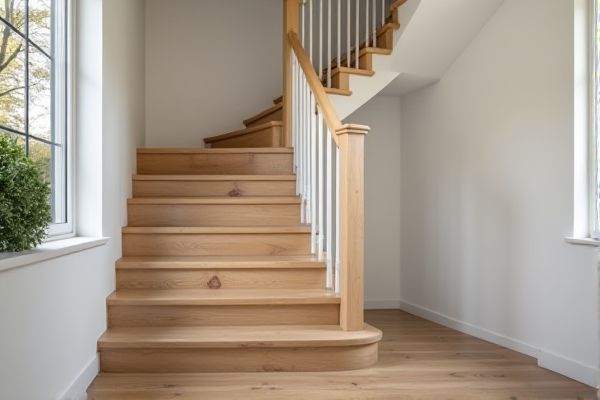
Modern stair nosing offers enhanced durability, slip resistance, and sleek designs using advanced materials like aluminum and rubber, while traditional stair nosing relies on classic wood or metal finishes that prioritize aesthetics and simplicity. Discover how choosing the right stair nosing can improve Your safety and style by reading the rest of the article.
Table of Comparison
| Feature | Modern Stair Nosing | Traditional Stair Nosing |
|---|---|---|
| Material | Aluminum, PVC, Rubber, Composite | Wood, Metal, Stone |
| Design | Sleek, minimalistic, customizable | Classic, ornate, bulkier |
| Durability | High resistance to wear and corrosion | Moderate, subject to wear and weathering |
| Slip Resistance | Enhanced grip with anti-slip inserts or textures | Limited slip resistance, often smooth surface |
| Installation | Easy, often clip-on or adhesive-backed | Requires nails, screws, or glue; labor-intensive |
| Maintenance | Low maintenance; easy cleaning | High maintenance; prone to damage and staining |
| Cost | Moderate to high, depending on material and design | Varies widely; wood and stone can be costly |
| Application | Commercial and residential; modern architecture | Residential and historical buildings |
Introduction to Stair Nosing: Modern vs Traditional
Modern stair nosing incorporates advanced materials like aluminum and PVC with anti-slip coatings, enhancing safety and durability compared to traditional wooden or metal stair nosing. These contemporary designs offer improved wear resistance, better aesthetics, and compliance with updated building codes. Traditional stair nosing often lacks the ergonomic features and longevity found in modern alternatives, making modern options superior for high-traffic and commercial environments.
Defining Modern Stair Nosing
Modern stair nosing integrates advanced materials like aluminum and rubber to enhance slip resistance and durability, contrasting with traditional wood or metal nosings prone to wear and less safety-focused designs. Engineered for ergonomic safety and aesthetic appeal, modern nosings often feature LED lighting and anti-slip coatings tailored for high-traffic commercial spaces. These innovations significantly reduce accidents and maintenance costs, positioning modern stair nosing as a superior choice for contemporary architecture.
Characteristics of Traditional Stair Nosing
Traditional stair nosing typically features materials such as wood, metal, or vinyl with simple, often rounded edges designed to enhance safety and durability. These nosings emphasize practicality with moderate slip resistance and straightforward installation, commonly found in older homes and commercial buildings. Their design prioritizes robustness over aesthetic versatility, contrasting with the sleek, customizable options available in modern stair nosing solutions.
Material Choices: Contemporary Innovations vs Classic Options
Modern stair nosing often utilizes advanced materials such as aluminum, PVC, and rubber composites, providing enhanced durability, slip resistance, and design flexibility compared to traditional wood or metal options. Contemporary innovations focus on lightweight, corrosion-resistant, and easily maintained solutions tailored to high-traffic or commercial environments. Your stair design benefits from these material choices by achieving improved safety and aesthetic appeal with minimal upkeep.
Aesthetic Impact and Design Flexibility
Modern stair nosing offers enhanced aesthetic impact through sleek profiles and customizable finishes, blending seamlessly with contemporary interiors. Traditional stair nosing often features bulkier designs with limited color options, which may not complement modern decor as effectively. Choosing modern stair nosing enhances your design flexibility by allowing tailored shapes and materials that elevate both safety and style.
Safety Features: Modern Enhancements Compared to Old Methods
Modern stair nosing incorporates advanced materials like non-slip rubber, LED lighting, and tactile indicators, significantly enhancing safety by improving visibility and grip. Traditional stair nosing often relies on simple metal or wooden edges that wear down quickly and offer limited slip resistance. Enhanced durability and compliance with current building codes make modern stair nosing a superior choice for preventing slips and falls.
Installation Techniques: Advanced vs Conventional Practices
Modern stair nosing utilizes advanced installation techniques like adhesive bonding combined with mechanical fasteners, providing superior durability and ease of application compared to traditional stair nosing, which relies primarily on nails or screws alone. These advanced practices often incorporate pre-drilled holes and interlocking designs that ensure a tighter fit and reduce installation time. Conventional methods may require more labor-intensive adjustments and higher maintenance due to less precise alignment and fixation.
Durability and Maintenance Requirements
Modern stair nosing features advanced materials like aluminum and vinyl composites, offering superior durability and resistance to wear compared to traditional wood or metal options. These contemporary designs require minimal maintenance, often needing only occasional cleaning to preserve their appearance and functionality. Choosing modern stair nosing enhances Your stairs' longevity while reducing upkeep efforts, making it a practical investment for high-traffic areas.
Cost Comparison: Upfront and Long-term Investment
Modern stair nosing typically involves higher upfront costs due to advanced materials like LED lighting and durable composites, offering enhanced safety and aesthetics. Traditional stair nosing, often made from aluminum or rubber, presents a lower initial expense but may require more frequent replacements or maintenance, increasing your long-term investment. Evaluating the balance between upfront affordability and longevity can guide your cost-effective stair nosing choice.
Choosing the Right Stair Nosing for Your Space
Modern stair nosing offers enhanced durability and slip resistance through advanced materials like aluminum and rubber, making it ideal for high-traffic or commercial spaces. Traditional stair nosing, often made from wood or metal, provides a classic aesthetic but may lack the same level of safety features required in contemporary settings. Choosing the right stair nosing for your space involves considering factors like durability, safety standards, and design preference to ensure optimal functionality and style.
 homyna.com
homyna.com